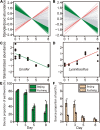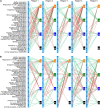Temporal Changes in the Function of Bacterial Assemblages Associated With Decomposing Earthworms
- PMID: 34456883
- PMCID: PMC8386022
- DOI: 10.3389/fmicb.2021.682224
Temporal Changes in the Function of Bacterial Assemblages Associated With Decomposing Earthworms
Abstract
Soil invertebrate corpse decomposition is an ecologically significant, yet poorly understood, process affecting nutrient biogeochemical cycling in terrestrial ecosystems. Here, we attempted to answer how the substrate chemistry and microbial community change during soil invertebrate (earthworm) decomposition and what roles microbes play in this process. Specifically, the dead earthworms (Amynthas corticis) were buried in two soils where the earthworms inhabited, or not, until more than 50% of the earthworm mass was lost. For both soils, earthworms decomposed faster during the early stage (between 0 and 3 days), as reflected by the higher rate of decomposition and increased accumulation of dissolved organic matter (DOM). This decomposition pattern was paralleled by bacterial community dynamics, where bacterial richness and diversity were significantly higher during early decomposition (p < 0.05) with the relative abundances of many genera decreasing as decomposition progressed. The succession of the bacterial community composition was significantly correlated with time-course changes in DOM composition (p < 0.05). Particularly, more functional groups (e.g., microbes associated with carbon, nitrogen, and sulfur cycling) were identified to be linked with the change of a specific DOM type during the early decomposition phase. By exploring the ecologically important process of soil invertebrate decomposition and its associated bacterial communities, this study provides evidence, e.g., a statistically significant positive correlation between bacterial community and DOM compositions, which supports the widely recognized yet less-tested microbial community structure-function relationship hypothesis in invertebrate decomposition.
Keywords: bacterial community; decomposition; dissolved organic matter; earthworm; structure–function relationship.
Copyright © 2021 Sun and Ge.
Conflict of interest statement
The authors declare that the research was conducted in the absence of any commercial or financial relationships that could be construed as a potential conflict of interest.
Figures








Similar articles
-
Variations in bacterial taxonomic profiles and potential functions in response to the gut transit of earthworms (Eisenia fetida) feeding on cow manure.Sci Total Environ. 2021 Sep 15;787:147392. doi: 10.1016/j.scitotenv.2021.147392. Epub 2021 Apr 29. Sci Total Environ. 2021. PMID: 34000543
-
Interactive effects of ozone depletion and climate change on biogeochemical cycles.Photochem Photobiol Sci. 2003 Jan;2(1):51-61. doi: 10.1039/b211154n. Photochem Photobiol Sci. 2003. PMID: 12659539 Review.
-
Functional and Structural Succession of Soil Microbial Communities below Decomposing Human Cadavers.PLoS One. 2015 Jun 12;10(6):e0130201. doi: 10.1371/journal.pone.0130201. eCollection 2015. PLoS One. 2015. PMID: 26067226 Free PMC article.
-
Microbial Interactions With Dissolved Organic Matter Drive Carbon Dynamics and Community Succession.Front Microbiol. 2018 Jun 8;9:1234. doi: 10.3389/fmicb.2018.01234. eCollection 2018. Front Microbiol. 2018. PMID: 29937762 Free PMC article.
-
Influences of evergreen gymnosperm and deciduous angiosperm tree species on the functioning of temperate and boreal forests.Biol Rev Camb Philos Soc. 2015 May;90(2):444-66. doi: 10.1111/brv.12119. Epub 2014 Jun 11. Biol Rev Camb Philos Soc. 2015. PMID: 24916992 Review.
Cited by
-
Relic DNA effects on the estimates of bacterial community composition and taxa dynamics in soil.Appl Microbiol Biotechnol. 2023 Jun;107(12):4109-4117. doi: 10.1007/s00253-023-12576-3. Epub 2023 May 16. Appl Microbiol Biotechnol. 2023. PMID: 37191685
-
Machine learning-based identification of key biotic and abiotic drivers of mineral weathering rate in a complex enhanced weathering experiment.Open Res Eur. 2025 Jul 3;5:71. doi: 10.12688/openreseurope.19252.2. eCollection 2025. Open Res Eur. 2025. PMID: 40792254 Free PMC article.
References
-
- Bastian M., Heymann S., Jacomy M. (2009). Gephi: an open source software for exploring and manipulating networks. Proc. Third Int. ICWSM Conf. 8 361–362.
-
- Benbow M. E., Barton P. S., Ulyshen M. D., Beasley J. C., DeVault T. L., Strickland M. S., et al. (2019). Necrobiome framework for bridging decomposition ecology of autotrophically and heterotrophically derived organic matter. Ecol. Monogr. 89:e01331.
-
- Benbow M. E., Receveur J. P., Lamberti G. A. (2020). Death and decomposition in aquatic ecosystems. Front. Ecol. Evol. 8:17. 10.3389/fevo.2020.00017 - DOI
LinkOut - more resources
Full Text Sources

